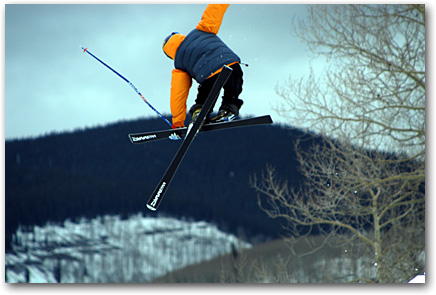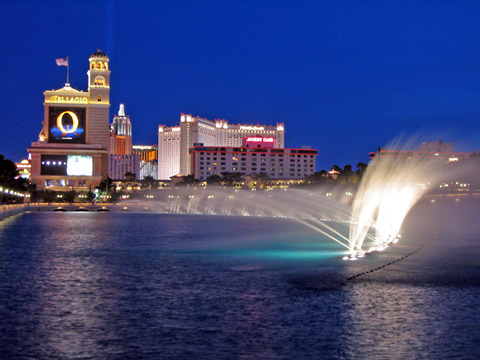Hi John,
Lots of good advice posted so far. The digital camera market is flooded right now with tons of options; it's a bit different than the early days when the only consumer digital camera available was the Apple QuicTake!
If your primary purpose will be taking pictures on the slopes, from experience I can tell you that you're most likely to take your camera with you if it's tiny and unobtrusive.
My primary camera is a Nikon D100 -- a digital SLR that is big and heavy, but takes excellent shots. I have several lenses, including one that has built-in active anti-vibration technology and weighs over 3 pounds -- more than the camera! I'll occasionally take this gear with me skiing, but very infrequently -- and I ski very cautiously with it, as you might imagine.
The benefit of a camera like the D100 is that you can get shots like this, which I took on a trip to Vail in 2003:

That shot wouldn't have been possible on a sub-$500 digital camera. But it became clear to me pretty quickly that I didn't want to lug around the D100 on most ski trips. I wanted to enjoy skiing, while being able to take decent shots that I could publish on DCSki.
So, I purchased the Canon PowerShot SD100 Digital Elph. It's a very lightweight, small, rugged camera that takes very good shots. (The newest version is the SD300.) The SD100 fits unobtrusively in my backpack, and has a reasonable level of optical zoom. I don't have to think twice about taking it with me skiing, and it also has enough "advanced" features to keep me happy. For example, I was able to swich it over to manual mode to get this reasonable shot at Las Vegas earlier this year:

Here are some of my recommendations:
- If grabbing photos while you ski is your main motivation, small size will be the feature you appreciate the most.
- Be very careful while skiing with a camera. If you have one in your front pocket and fall, the camera could crush your ribs. For that reason, even with a camera as tiny as the Canon Digital Elph, I alway carry it in a backpack, usually wrapped in a small towel.
- Although I agree with Jarrett's preference for Compact Flash, the small cameras are too small to support that type of memory. The Digital Elph (and most other tiny ones) use SD memory cards. Memory cards are quite cheap these days, though, especially if you shop around.
- If you'll mainly be publishing to the Web, you don't need more than 4.0 megapixels. In fact, anything between 3-4 megapixels would be good. I wouldn't go beyond 4.
- As others have noted, ignore any specs related to digital zoom. Digital zoom is worthless, because you lose resolution as you "zoom" in closer. (And you can do higher quality digital zooms after the fact, on the computer.) Optical zoom is what matters, and a 3x optical zoom is decent. The current Canon SD300 has a 3x optical zoom, which is pretty good for a small camera of that size. The smaller a camera is, the less optical zoom it can have, because optical zoom takes more glass and depth.
- I haven't had any problem with cold or moisture with my Canon SD100. It has built-in Lithium Ion batteries that do well in the cold. Lens fogging can be an issue -- especially when the camera goes through drastic temperature changes. It's always a good idea to bring some alcohol-based lens cleaner towelettes (you can buy them at Lens Crafters), but if it's cold enough, the liquid can ice up on the lens.
- It's difficult to take well-exposed pictures in the snow. All of the bright white confuses the camera, resulting in underexposed pictures. Study the camera's manual to understand how it meters light and to see what options you have. Most cameras have several different photo taking modes, or will let you increase or decrease the exposure manually if you know a certain shot is likely to be over or underexposed. If the camera supports spot metering, learn how to use it.
I think the Canon SD300 meets your criteria and would be a great choice for what you want to do. (Here's a link to Canon's
web page for the SD300.) But there are lots of options there. I'd recommend swinging by Best Buy or another store and seeing how the different cameras feel in your hand. You might like the feel of some over others. And some of the cameras are very plasticky; one thing I really like about the SD300 is that it feels like a solid chunk of aluminum; that adds a bit of extra weight but it can certainly take a beating.
- In terms of accessories, most consumer digital cameras come with a memory card that has minimal capacity. So plan on buying a higher-capacity memory card. Other than that, the only other accessory you might want is a small carrying bag to add some padding.
- You might also want to buy a copy of Adobe Photoshop Elements 3.0 if you have any interest in photo enhancement/manipulation on the computer. It has most of the power of the full version of Photoshop but at a cheap price (about $99). With Photoshop, you can salvage bad photographs and make good ones excellent. Plus, it's a lot of fun.
Hope that helps!
- Scott







 , but did use the VR lens while wandering about Big Meadows taking pictures of deer, the sunset, etc. (You can see some of the shots on my blog; I've been too busy to write up a Firsthand Report for DCSki.) If I were in a "photojournalist" mode, for example shooting a busy event, I would definitely take the VR. But, even with the VR, I find a tripod shot (when possible) is always better than a non-tripod shot, so I consider a tripod indispensable.
, but did use the VR lens while wandering about Big Meadows taking pictures of deer, the sunset, etc. (You can see some of the shots on my blog; I've been too busy to write up a Firsthand Report for DCSki.) If I were in a "photojournalist" mode, for example shooting a busy event, I would definitely take the VR. But, even with the VR, I find a tripod shot (when possible) is always better than a non-tripod shot, so I consider a tripod indispensable.